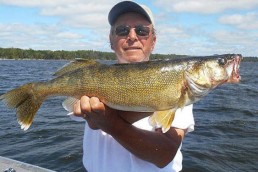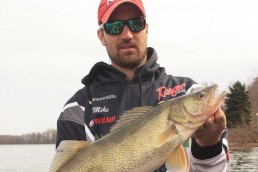Slip Bobber Walleyes
SHARE THIS POST
On so many natural lakes, slip bobbers are deadly on walleyes—particularly early in the season. Cold fronts, crashing water temps and dirty water accompanied by strong winds might absolutely wreck many bites, but slip bobbers still seem to catch fish during these tough conditions. It’s tough to beat a lively leech squirming in place just for the sake of catching walleyes. Here is how to target slip bobber walleyes.
The other reality with slip bobber fishing, however, is that finding fish is a probe. Pick what you believe to be the spot on the spot with the highest probability for contacting fish. Get methodical, and your search process needs to get slowed way down. You may indeed be thorough but make no mistake: Slip bobbers can also sometimes be a really tedious and difficult way to eliminate water and find fish.
Where to Start
So often early in the season, trends like water temperature or instable weather are going the wrong direction. I find that I will still catch some walleyes up shallow by pitching jigs with bait, jigs with plastics, swimbaits, crankbaits, etc., but the bite is a tough grind. Going back through an area with slip bobbers, where I could previously only catch a few fish with cast-and-reel presentations, often saved the day. The difference was often striking. In this context, slip bobbers complement other cast-and reel-presentations. The other presentations catch a few fish, enable you to sample water and find fish. The slip bobber might not be the best presentation to look for fish, but it sure does catch fish once you find them.
Slip bobber fishing, however, also gives you a tremendous education on how fish move through a location. With slip bobbers, you will quickly realize that any location has sweet spots where it seems like every fish uses them. As the fish move through a location or along a shoreline, it often seems like the route of travel is preordained, much like deer following a deer trail. Walleyes using reefs or rock piles might follow the edges of boulders a certain way. Fish running along shorelines might travel a specific distance from shore that seems to be a more important factor than a specific depth. Slip bobber fishing allows you to really learn a location and really understand how fish use that location. You can even begin to understand the orientation of fish movements in the direction fish are pulling the bobber under.
Take Advantage
Depending on the state you are fishing and how many rods you can use, keeping several slip bobbers in the water can keep you busy. With most scenarios, the boat will be anchored and you want to use the wind as an advantage. Keep the boat upwind from the target you want to fish. Ultimately, the slip bobbers will settle in a line downwind from the boat, and although everything is stationary, each slip bobber will have a drift that must be managed.
Successful slip bobber fishing is often a matter of managing slip bobber drifts next to the boat and keep slip bobbers drifting continually through key spots. This management is often simply a rod location where the rod and bobber furthest downwind eventually iss reeled up and repositioned furthest upwind. The key is to keep nice open lanes between slip bobbers and have your rods follow the order of your slip bobbers. Typically, this is much easier to accomplish with several rods if you can anchor the boat sideways with two traditional anchors or an anchor and a Talon.
There are many differences in opinion on slip bobber setups, and preferences do change from region. I consider slip bobber fishing a methodical, almost finesse presentation in that you are sticking and keeping good live bait right in front of a fish. On the other hand, I also bring almost a power fishing mentality to slip bobber fishing.
The Setup
On Devils Lake where we are fishing flooded trees, I like to use a heavier braided line for my main line. Bobber knots don’t grip and stick on braid like mono, so you need to use heavier braided line for the bobber knots to work. I have found a heavier braid like 14- or 20-pound-test Power Pro works perfect because the bobber knots stick in place better and the line is very durable. Use two bobber stops stacked on top of each other in tandem.
I like to use a larger, 1- to 1 ¼-inch diameter slip bobber that is easy to cast and easy to see. Again, this larger slip bobber might seem like overkill, much like the heavier line, but the key to the larger slip bobber is that it allows you to use more weight. Below the slip bobber, I like to add a sliding 1/8- to ¼-ounce egg sinker above a snap swivel. The heavier weight pulls the line through the slip bobber fast and the presentation gets through the water column quickly. This fast setup time is crucial around wood when managing several lines, or if power corking when you are hunting for fish with your electronics.
Are you enjoying this post?
You can be among the first to get the latest info on where to go, what to use and how to use it!
Early in the season, I find that a snelled hook is as deadly as anything else. I believe part of the slip bobbers’ allure early in the season is that the slip bobber and weight can bob up and down in strong winds, but the action on a plain snell below the swivel is often subdued and cushioned. This passive and subdued action on a lively leech is deadly during tough conditions early in the season. In cold weather, I find that wacky-hooking (through its middle) a medium to small leech on a plain hook will catch fish when nothing else will.
As the water warms up, I find that I can use a smaller weight above the swivel and start to incorporate jigs that add some color and flash. I use a lot of Northland Fishing Tackle Whistler Jigs throughout the summer where I tip with either a leech or half ‘crawler. Shiners and minnows can also work well depending on the water. Most days on most waters, however, the ribbon leech is king.
Equipment
Long rods are often preferred for slip bobbers and, as most can assume, you don’t need to necessarily have the highest quality rod from a weight or sensitivity perspective. Just a simple 7-foot spinning rod that has a moderate action like the Scheels Outfitters Guide Series will suffice. I often also don’t like to use rod holders, and instead prefer to lay the rods on the gunwale far enough inside the boat where fish can’t easily pull the rod over the side, just so I can move rods faster and easier while keeping nice lanes open between each slip bobber. I use my Talon a lot when slip bobber fishing, often use in conjunction with a heavy anchor and attached chain, so that I can pin the boat down in one spot on short amounts of anchor rope in strong wind.
If I am trying to sharpshoot fish with my electronics, I am typically keeping the bowmount trolling motor down so I can use Spot Lock and Side Imaging. On places like Mille Lacs where it is very popular to drive around locations to find and mark pods of fish, and then pitch to those fish with slip bobbers, these fish are often suspended. So, find the distance the fish are from the bottom by measuring how far the fish is from the shadow on your side imaging.
Once you know an approximate distance from the bottom, figure out the approximate distance from the top, and use your body as a ruler for quickly sliding your bobber stop into the correct position on you line. I am a little over six feet tall, for example. If fish are 15 feet down, I just go twice my height, plus a few more feet.
If you are going to commit to a location, using a traditional lead, clip-on depth finder works for exactly setting your depths. But when you are running-and-gunning, use your body, arm width or rod length to measure faster.
Slip bobbers save the day during tough conditions. We haven’t seen or fished on many natural lakes where slip bobbers didn’t work. Early in the season, this simple and effective presentation is often at its best. From emerging weed lines, rock reefs and pencil reeds to flooded timber and shoreline structure, slip bobbers simply catch walleyes. What is most amazing is just how incredibly deadly a simple, squirming leech on a plain hook is early in the season when other presentations are just a grind, particularly when walleyes are shallow less than ten feet of water after cold fronts during ugly weather.
Become a MidWest Outdoors Insider here!
MWO
SHARE THIS POST
Did you enjoy this post?
You can be among the first to get the latest info on where to go, what to use and how to use it!
Jason Mitchell
Jason Mitchell was a top walleye guide on Devils Lake, N.D. for nearly 20 years. Today, Mitchell produces the Jason Mitchell Outdoors TV program. Visit jasonmitchelloutdoors.com for more.



